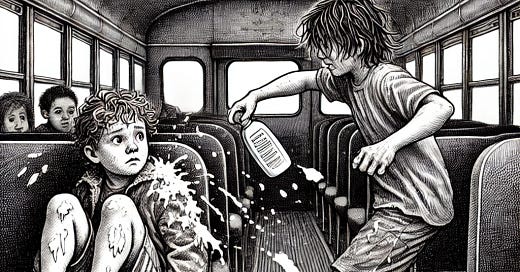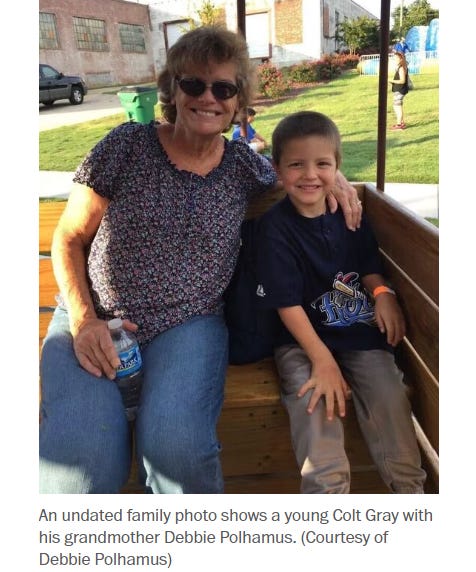Georgia school shooter: Severe child abuse and a broken social services system
14-year-old school shooter attended 6 schools in 5 districts, child services was called at least 5 times, and he had contact with 5 different police agencies before the shooting.
When the Apalachee High school shooter was in 7th grade, kids on the school bus would throw shampoo bottles at him because he smelled so bad.
The 11-year-old kid reeked of garbage because he lived in a house that was full of trash instead of furniture. Both of his parents were drug-addicted and abusive per a series of in-depth interviews with family members, relatives, and neighbors conducted by The Washington Post. The drugs and physical abuse were so bad that his mother threatened to kill him while she was high on meth.
Note 1: The alleged behavior by the shooter and his parents is based on interviews and she has not been charged with any crimes relating to the school shooting.
Note 2: I decided to include two photos of the Apalachee High school shooter to show that he was just another kid at school right up until he pulled the trigger. When we immediately label school shooters as “monsters”, this is a narrative used to absolves society of responsibility.
As we continue to grapple with why a 14-year-old kid would murder random students and teachers at a school that he just started attending, we need to understand what was going on in his life. Here are a few key points from the Washington Post article (The making of an alleged school shooter: Missed warnings and years of neglect):
When he was in 6th grade in 2021, he was caught looking up how to kill his father on the tablet computer owned by his school.
Later that year, he was taken from his parents by child protective services after a domestic violence situation. A mandatory report from child protective services was not processed by the local police department.
In October 2022, he was physically beaten by his mother and locked out of his house in the cold overnight.
A month later, child services took him away from his mother again after concerns that she would harm him.
In May 2023, he posted a message in an online forum with a photo of 2 rifles saying he was ready to commit a school shooting. This is the same post that Georgia police failed to properly investigate during a sloppy, botched interview.
In the fall of 2023, he was living with his mother again and became violent at home in October. One night he broke windows in the house and slashed furniture with a knife. When police and child protective services investigated, his mother tested positive for alcohol, hydrocodone, OxyContin, meth, and Adderall.
In early November, his mother was high on meth, taped his sister to a chair, and texted that she was going to kill her son. Her threat haunted the teen for months and pushed him further into a state of paranoia.
For Christmas in December 2023, his father bought him an AR-15 rifle. It’s unclear how his father legally bought guns after alleged illegal drug use and domestic violence.
Three weeks before the shooting, the 14-year-old allegedly grabbed his AR-15 rifle during a physical confrontation with his mother in his bedroom. His grandmother believes that is when he “stopped believing his life would get better”.
The morning of the shooting, he texted his father, brother, and sister to tell them he was sorry. Family members frantically contacted the school but he started shooting before school officials took meaningful action.
In a video posted online in January by his mother, his father praises him for his shooting skills after killing a deer from 107 yards away (more than a football field). He was back with his parents less than 2 months after his mother was high on illegal drugs and threatened to kill him.
Same pattern of abuse and trauma as other school shooters
“When reaching out for help hurts you, you figure out some way to make people hear you.”
Reading these details about the Georgia school shooter’s life and family parallel the conversation that I had with Aaron Stark last month. Aaron was the victim of severe abuse and he was plotting a school shooting until one act of kindness by a classmate showed him that his life had value.
Me: So let's take a moment and just unpack your background a little more because I think that it's really important to understand how you could see yourself in the shoes of this 14 year old school shooter or other school shooters. You were in a position where you were moving between schools, you were moving between houses, you had really abusive, drug-addicted parents, and you felt forgotten by the system. And that made you think your life had no value, that made you think about suicide, and ultimately... A school shooting is a violent public suicide, but why a school shooting?
Why is there that feeling to inflict pain on others as you're also experiencing that profound desire to die? Because I think people don't understand that.
Aaron Stark: Well, there was a point where... So for my story, to get into more detail with it, my family was... My birth to five, I was living with my father. That was like a Stephen King movie. It was just abject horror. He was the most violent and depraved individual I've ever met.
I'm talking beatings and rapes and chased across the country being hunted, that kind of stuff. And when my mom finally left him, got with my stepdad, I spent the next 15, 20 years with him in my life. And that was... crack cocaine and violence and crime and stealing and robbing and domestic violence every single day, constantly going from zero to a hundred every single day. And in that time, I'm moving back and forth across the country, going from Oregon to Colorado, bouncing state to state because it was late eighties, early nineties. And so it was really easy to create a whole new identity. You move up to another state, lie about your whole life, get a new job, get a new, uh, get a new house and Six months later, you lose all that wash, rinse, repeat, bouncing back and forth. So for me as a kid living in all that, it was the complete lack of any kind of stability, any kind of personal identity.
Anything I had, all the material stuff I had would disappear. So I didn't have any, like, because we'd get evicted. So all the toys I had and stuff, I would have someone burst into my bedroom at three o'clock in the morning, throw a duffel bag at me, say, we need to grab all this stuff.
We need to get out of here. And what choice do I have? The only thing I would ever take was my comic books because I didn't have enough time to grab all the other stuff. And so nothing in my life had any kind of object permanence. It was everything could be gone at a moment's notice.
At the same time, I am fat and smelly and dirty because I'm not taking care of myself. My family are crackheads. They're literal digging through the carpet looking for crack rock. I took crack to school for show and tell to show one of the parallels with this kid screaming out for help.
My full uncut interview with Aaron: Ep 14. Society, institutions, & communities have failed when a 14-year-old takes an AR-15 into Apalachee High
Broken system
I wrote about systemic failures days after the school shooting in Georgia. The list of these failures continues to grow as more information is available:
FBI, Georgia law enforcement (at least 5 different police agencies), five school districts, and multiple child protective services agencies failed to document problems, share information, and take meaningful action on obvious red flags.
Patrol officers in Georgia lacked the skills and training needed to conduct a field interview and document a routine police investigation after a kid posted a picture of his rifles and said he was ready to commit a school shooting. There are basic best practices for conducting an interview that every officer should be trained on.
Shooter’s parents allegedly had multiple drug arrests, failed drug tests, domestic abuse, and had their child taken by protective services yet his father was still able to legally buy multiple firearms in Georgia.
Lack of emergency action planning and training at Apalachee High for how to deal with a phone call about an imminent threat. School officials allegedly wasted 30 minutes after a phone call warning instead of taking immediate action to protect students.
School staff spent time searching for the wrong student because they lacked resources, training, knowledge about enrolled students, or didn’t have systems to figure out where students were on campus.
While Georgia has spent +$104M on school security tech, it appears that the state lacks a system to transfer education records and information about prior threats. In a resource constrained environment, new security tech like panic button badges may have distracted administrators from critical tasks like planning and training for an imminent threat on campus.
Solutions
There are three steps we can take to stop many school shootings:
Public education and standardized reporting system similar to “see something, say something” after 9/11 so that anyone who spots “red flags” can easily report them to police. The system needs to be managed federally so that every report is investigated, the dots are connected, and critical information doesn’t slip through the cracks. (Read more: What can the average person do to prevent the next school shooting?)
Fully funded crisis intervention programs in every community to help someone who is suicidal or shows risk factors before they decide violence is their only option. (See: The Off Ramp Project)
Every state needs to pass laws that require guns to be stored inside a locked safe and hold the legal owners criminally and civilly liable for crimes that are committed with their unsecured firearm. When an adult buys an AR-15 for a 14-year-old as a Christmas present, this is a ‘straw purchase’ where a legal buyer is obtaining a firearm for a prohibited person (kid under 18). Parents need to be held criminally responsible if they provide firearms to children who can’t legally own or buy them.
David Riedman is the creator of the K-12 School Shooting Database, Chief Data Officer at a global risk management firm, and a tenure-track professor. Listen to my weekly podcast—Back to School Shootings—or my recent interviews on Freakonomics Radio, New England Journal of Medicine, and my article on CNN about AI and school security.







Society failed this kid and fails so many more.